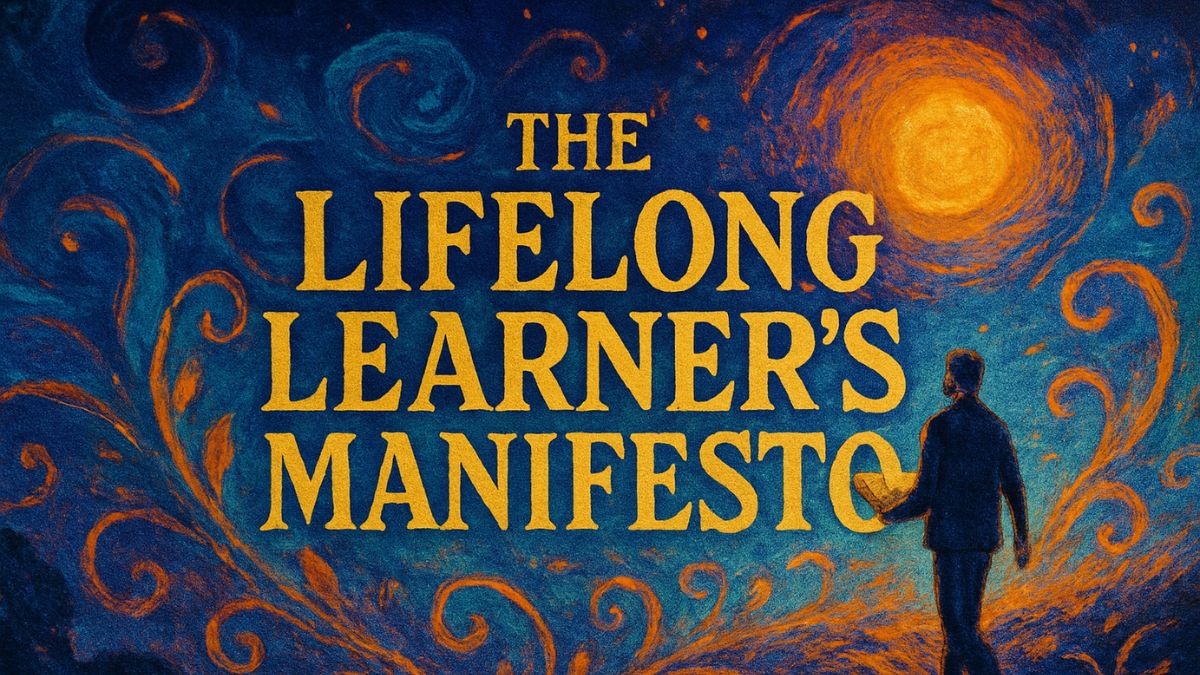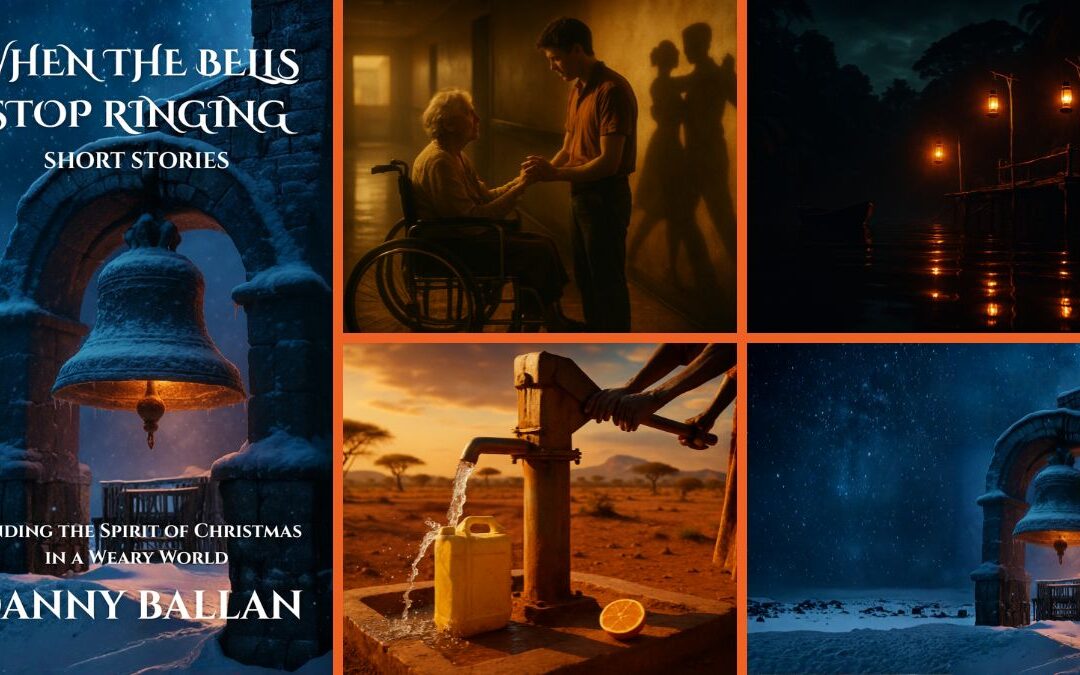Audio Article
In a world saturated with information, where trends shift like desert sands and the future arrives faster than we can plan for it, it’s easy to feel adrift. We are inundated with advice, with life hacks, with the five steps to this and the seven secrets to that. But a collection of tactics is not a strategy, and a list of rules is not a philosophy. What a modern mind truly needs is not another map for a constantly changing landscape, but a reliable internal compass. We need a North Star.
A manifesto, in its purest form, is just that. It is a public declaration of intent, of principles, of a core philosophy. It’s a stake in the ground that says, “This is what I believe. This is how I intend to operate. This is the ethos that will guide my choices when the path is unclear.” While often associated with grand artistic or political movements, the most powerful manifestos can be the personal ones—the quiet credos we adopt to navigate our own lives with purpose and intention.
What follows is such a manifesto. It is a distillation of the biggest ideas from the world of learning, growth, and cognitive science into ten guiding principles. This is not a checklist to be completed, but a set of ideals to be lived. It’s a philosophy for anyone who believes that their education did not end with a diploma, but began with a conscious choice to remain curious for life.
Consider this your motivational anchor. Refer to it when you feel stuck, when you are intimidated by a new challenge, or when you forget the profound joy that lies in the simple act of learning something new. This is the Lifelong Learner’s Manifesto.
The 10 Principles of Lifelong Learning
Principle I: I Am a Work in Progress, Not a Finished Product.
This is the cornerstone upon which all other principles are built. I reject the fallacy of fixed talent and static intelligence. I understand that my brain is not a block of concrete, but a dynamic, living network capable of growing and changing until the day I die. My abilities are not carved in stone; they are forged in effort. I will not define myself by my current limitations, for they are temporary. Instead, I will define myself by my potential for growth. When I say, “I can’t do that,” I will add the silent, powerful promise: “…yet.” My identity is not tied to being “smart” or “talented,” but to the act of becoming smarter, more capable, and more skillful through deliberate practice. I am a process, not a finality.
Principle II: Curiosity Is My Compass.
I will not let my learning be dictated solely by the demands of my job or the expectations of others. While practical skills are essential, my growth will be guided by the magnetic pull of my own genuine curiosity. I will ask “Why?” and “How?” and “What if?” like a child, and I will follow those questions down rabbit holes of discovery. I will read the book that has nothing to do with my career. I will learn the skill that has no immediate practical application. I will honor the sparks of interest that flicker in my mind, for they are the embers of passion and the wellspring of creativity. I understand that a life without curiosity is a life lived in monochrome. I choose to see the world in vibrant, inquisitive color.
Principle III: I Will Embrace “Glorious Failure.”
I will fundamentally reframe my relationship with error. Failure is not a verdict on my worth, but a vital source of data. It is the tuition I pay for a world-class education. I will not shy away from challenges for fear of making mistakes; I will actively seek out the edges of my competence, for that is where true learning resides. When I stumble, I will not ruminate on the shame of the fall. I will get curious about the physics of the trip. What did I miscalculate? What can I learn from this? I will celebrate my most spectacular failures as my most potent teachers, for they reveal the weaknesses in my understanding and illuminate the path to mastery.
Principle IV: The Expert Was Once a Beginner.
I will approach every new domain with profound humility. I will grant myself the grace to be clumsy, to be slow, to ask the “stupid” questions. I will remember that every master of a craft, every celebrated genius, every person I admire for their skill, once stood on the same starting line where I now stand: at zero. Their expertise is not a testament to some innate gift, but to their perseverance through the awkward, frustrating, and humbling phase of the beginner. I will not be intimidated by their mastery; I will be inspired by their journey. I will not compare my chapter one to someone else’s chapter twenty.
Principle V: I Will Connect the Dots.
I will resist the temptation to keep my knowledge in isolated silos. A skill learned for my job is not separate from a concept learned in a history book or an insight gained from a piece of art. I will actively look for the patterns, the analogies, and the underlying principles that connect disparate fields. True wisdom is not found in the depths of a single well, but in the understanding of the underground rivers that connect all wells. I will be an interdisciplinary thinker, borrowing mental models from biology to understand business, from physics to understand philosophy, from music to understand mathematics. This is how innovation is born. This is how a rich, integrated understanding of the world is built.
Principle VI: Rest Is Part of the Work.
I will respect the biology of my own brain. I understand that learning is not a function of brute force, but a delicate dance between focus and relaxation. I will not sacrifice sleep in the name of “hustle,” for I know that sleep is when my brain consolidates memories and solidifies new connections. I will embrace periods of deliberate rest, of long walks, of mindless play, not as procrastination, but as a vital part of the cognitive process. I will allow my mind to go into “diffuse mode,” for it is in these moments of unfocused thought that the “aha!” moments of insight often strike. I am a human, not a machine, and I will honor the rhythms of my own nature.
Principle VII: I Will Learn by Doing.
I will not mistake the consumption of information for the acquisition of skill. Reading a book about swimming is not the same as swimming. Watching a tutorial on coding is not the same as writing code. Knowledge is inert and theoretical until it is applied. My learning journey will therefore be biased toward action. I will build the project, write the essay, create the prototype, have the conversation. I will close the book and open the toolbox. My goal is not to become a library of facts, but a workshop of capabilities. I learn best when my hands are as engaged as my head.
Principle VIII: I Will Be a Teacher.
I believe that the highest form of understanding is the ability to explain a concept simply. Therefore, I will actively seek out opportunities to share what I learn. I will explain a new idea to a friend, write a blog post summarizing a book, or mentor someone just starting on a path I have already walked. This is not just an act of generosity; it is a powerful learning strategy. The act of teaching forces me to clarify my own thinking, to confront the gaps in my knowledge, and to organize information into a coherent narrative. In becoming a teacher, I become a better student.
Principle IX: My Library Is Everywhere.
I will dismantle the artificial walls between “learning time” and “living time.” I do not need a classroom or a formal course to learn. My library is the world. It is the conversation with the barista, the architecture of the city I walk through, the podcast I listen to on my commute, the feedback from a colleague, the questions of a child. I will cultivate a state of perpetual observation and receptiveness. I will carry questions with me throughout my day and look for answers in unexpected places. Learning is not an event I schedule; it is a lens through which I view my entire life.
Principle X: The Goal Is the Journey.
Finally, and most importantly, I will fall in love with the process, not just the outcome. While goals are useful for direction, my self-worth will not be contingent on achieving them. I will find joy in the daily practice, in the small increments of improvement, in the satisfying struggle of grappling with a difficult problem. I will celebrate the effort as much as the achievement. I learn not to arrive at a destination called “Mastery,” but to enjoy the rich, challenging, and infinitely rewarding journey of growth. This path has no end, and that is its greatest beauty.
Living the Manifesto
This manifesto is not a set of rigid, unbreakable laws. That would be a dogma, and dogma is the enemy of learning. Instead, see this as your personal constitution, a living document to guide your decisions. It’s a reminder of the person you aspire to be.
Living these principles is a practice. Some days you will embody them fully. Other days you will fall short. That’s okay. The point is not perfection, but direction. The point is to wake up each morning and recommit, in some small way, to the path of the lifelong learner—to the belief that our best selves are not behind us, but are perpetually waiting to be discovered.
MagTalk Discussion
Focus on Language
Vocabulary and Speaking
Hello there. Let’s take a closer look at the engine of that article—the words themselves. A manifesto, by its nature, uses strong, principled language. It’s designed to be inspiring and memorable. We’re going to pull apart ten of the key words and phrases that gave the manifesto its power. We’ll explore their nuances, see how they functioned, and discover how you can integrate them into your own speech to sound more articulate and thoughtful.
Let’s begin with the title word itself: manifesto. The article opens by saying, “A manifesto, in its purest form, is just that. It is a public declaration of intent, of principles, of a core philosophy.” A manifesto is not just a plan or a list of ideas; it’s a bold, firm statement of beliefs and intentions. Think of the Communist Manifesto or the Declaration of Independence. They are foundational documents. While we used it in a personal context, it carries that weight of seriousness and conviction. You can use this word to add a little dramatic flair and importance to your own plans. For instance, if you’re passionate about a new approach at work, you could present your proposal and say, “This is more than just a plan; it’s our team’s new manifesto for how we approach creativity.” It elevates the idea from a suggestion to a core philosophy.
This brings us to a related word: credo. We said, “…the most powerful manifestos can be the personal ones—the quiet credos we adopt to navigate our own lives.” A credo is a statement of the beliefs or aims that guide someone’s actions. It comes from the Latin word for “I believe.” It’s very similar to a manifesto but feels a bit more personal and less public. It’s your personal code of conduct. You could say, “My professional credo is to always leave things better than I found them.” Or, “Honesty and compassion are the two main pillars of my personal credo.” It’s a beautiful and sophisticated way to talk about your core beliefs.
Now for a word we want to fight against: fallacy. Principle I states, “I reject the fallacy of fixed talent and static intelligence.” A fallacy is a mistaken belief, especially one based on an unsound argument. It’s a flaw in reasoning that leads to a false conclusion. The idea that you’re “born bad at math” is a classic fallacy. This is a fantastic word to use when you want to strongly and intelligently discredit an idea. Instead of just saying, “That’s a wrong idea,” you could say, “The popular belief that you need to be a ruthless person to succeed in business is a complete fallacy.” It signals that you’ve thought critically about the topic and identified a logical flaw.
Let’s talk about humility. Principle IV says, “I will approach every new domain with profound humility.” Humility is the quality of having a modest or low view of one’s own importance. It’s the opposite of arrogance. In the context of learning, it means being willing to admit you don’t know something and being open to learning from anyone or anything. It’s a highly respected character trait. You can praise someone by saying, “Despite his incredible success, he has a remarkable sense of humility.” Or you can use it reflectively: “That experience taught me a great deal of humility.”
A core idea in the manifesto is to be interdisciplinary. Principle V encourages us to be an “interdisciplinary thinker.” This adjective describes something that involves two or more different academic subjects or areas of knowledge. An interdisciplinary approach to a problem might combine insights from psychology, economics, and history. It’s about breaking down the walls between subjects. This is a very valuable concept in the modern world. You could say, “Our team is interdisciplinary, with engineers, designers, and sociologists all working together.” Or, “She has an interdisciplinary background in both art and computer science, which makes her work unique.”
Next, let’s look at the word inert. In Principle VII, we said, “Knowledge is inert and theoretical until it is applied.” Inert means lacking the ability or strength to move. In chemistry, an inert gas is one that doesn’t react with other chemicals. Metaphorically, it means something is lifeless, motionless, or without effect. Knowledge that just sits in your head is inert; it doesn’t do anything. This is a powerful, vivid word. You could describe a boring meeting by saying, “The whole team just sat there, inert, waiting for someone to say something.” Or you could criticize a plan: “On paper, the strategy looks good, but without proper funding, it will remain inert.”
This is connected to the idea of a silo. Principle V says, “I will resist the temptation to keep my knowledge in isolated silos.” A silo is a tall tower on a farm used to store grain, and each silo keeps its contents separate. In a business or intellectual context, a silo is a system, process, or department that operates in isolation from others. It’s a very common and useful piece of jargon. You’ll often hear managers say, “We need to break down the silos between the marketing and engineering departments. They need to communicate more.” You can also use it for yourself: “I realized I was in a professional silo and needed to learn about other parts of the business.”
Let’s look at a beautiful word from Principle IX: ubiquitous. While not in the final text, the principle “My Library is Everywhere” perfectly embodies this idea. Something that is ubiquitous is present, appearing, or found everywhere. Think of smartphones or the internet—they are ubiquitous in modern life. It comes from the Latin word ubique, meaning “everywhere.” It’s a more formal and impressive way to say “everywhere” or “widespread.” For example, “In the summer, the sound of cicadas is ubiquitous in this region.” Or, “The company’s logo has become ubiquitous thanks to their aggressive marketing.”
The manifesto also talks about the need to consolidate learning. Principle VI says that sleep is when “my brain consolidates memories.” To consolidate means to combine a number of things into a single, more effective or coherent whole. It also means to make something physically stronger or more solid. Both meanings apply to learning. Your brain takes scattered pieces of information and consolidates them into a stable memory. You can use this in many contexts. A company might consolidate its various debts into a single loan. Or a leader might say, “We have a lot of good ideas, but we need to consolidate them into a single, clear strategy.”
Finally, let’s consider the word dogma. The conclusion warns, “This is not a set of rigid, unbreakable laws. That would be a dogma…” A dogma is a principle or set of principles laid down by an authority as incontrovertibly true. It’s a belief that you are not allowed to question. It’s often used in a religious context, but it can apply to any field where there is a rigid, unquestionable set of beliefs. It generally has a negative connotation. You could say, “He’s a great scientist because he’s always willing to challenge the established dogma in his field.” Or, “We need flexible solutions, not a rigid adherence to outdated dogma.”
So we have: manifesto, credo, fallacy, humility, interdisciplinary, inert, silo, ubiquitous, consolidate, and dogma. These are words that deal with big ideas, beliefs, and structures.
Now for our speaking lesson. A manifesto is a series of powerful, declarative statements. The speaking skill that brings a manifesto to life is conviction. When you speak with conviction, people believe you. A key technique for sounding convicted is using downward intonation.
In English, when we ask a question, our pitch typically goes up at the end of the sentence (“Are you coming?”). When we are unsure or listing items, our pitch might stay level or go up slightly. But when we state a fact or a strong belief, our pitch should go down. It signals finality and confidence.
Compare these two:
- “I believe curiosity is my compass.” (voice goes up at the end, sounds like a question or an uncertainty)
- “I believe curiosity is my compass.” (voice goes down at the end, sounds like a firm, unshakeable belief)
That drop in pitch is subtle but incredibly powerful. It makes your statement sound like a conclusion, not an opening for debate.
Here’s your speaking challenge: I want you to choose the three principles from the manifesto that resonate with you the most. Write them down. Then, I want you to practice saying them out loud. Your goal is to end each and every sentence with a clear, firm, downward intonation. Record yourself on your phone. Listen back. Do you sound confident? Do you sound like you truly believe what you’re saying? This isn’t about being aggressive; it’s about being grounded and certain in your speech. Mastering this small vocal trick can profoundly change how people perceive your confidence and the strength of your ideas.
Grammar and Writing
Welcome to the writing workshop. Today, we’re moving from reading a manifesto to writing one. A manifesto is a unique form of writing; it’s part poetry, part legal document, part declaration of war on old ideas. It needs to be crafted with care to have the right impact. The language must be strong, clear, and resonant.
Here is your writing challenge:
Write your own “Personal Manifesto” of 500-700 words. Choose one specific area of your life—it could be your career, your creative practice, your approach to health and fitness, or your philosophy on relationships. Outline 5 to 7 core principles that guide you in that area. Each principle should be a bold, declarative statement, followed by a short paragraph that explains its meaning and importance to you.
To make your manifesto powerful and not just a list of nice ideas, you’ll need to command a few key grammatical and rhetorical tools. Let’s break them down.
First and foremost is the declarative sentence. This is the bedrock of any manifesto. A declarative sentence simply makes a statement or expresses an opinion; it declares something to be true. It ends with a period. “I will embrace glorious failure.” “The goal is the journey.” Your principles must be written as confident, unambiguous declarative sentences. Avoid wishy-washy language like “I kind of think maybe…” or “It might be a good idea to…” Be direct. State your belief as a fact.
The second tool is a powerful rhetorical device called anaphora. Anaphora is the repetition of a word or phrase at the beginning of successive clauses or sentences. It creates a powerful rhythm and reinforces a central theme, making your writing sound epic and memorable. Martin Luther King Jr.’s “I have a dream…” speech is the most famous example of anaphora.
In the manifesto we read, nine of the ten principles started with “I will…” or “I am…” This was a deliberate use of anaphora. It ties the principles together and frames them as personal commitments.
- Without Anaphora: “Curiosity is important. Failure should be embraced. Being a teacher is good.” (Correct, but flat).
- With Anaphora: “I will be guided by curiosity. I will embrace failure. I will learn by being a teacher.” (Rhythmic, personal, powerful).
As you write your own manifesto, consider starting each principle with the same phrase, such as “I believe…”, “I will…”, or “My commitment is to…”
Next, let’s talk about tense. The most effective manifestos are written primarily in the simple present tense. This tense is used for habits, unchanging situations, general truths, and fixed arrangements. By writing your principles in the present tense (“Curiosity is my compass,” “Rest is part of the work”), you give them a timeless, universal quality. They are not just suggestions for the future; they are presented as enduring truths. Avoid getting bogged down in past or future conditional tenses. State what is.
Finally, a manifesto deals with big, abstract nouns. These are nouns for ideas, qualities, or states rather than concrete objects: humility, curiosity, knowledge, growth, integrity. The risk with abstract nouns is that they can make your writing sound vague and full of hot air. The key is to always ground them in concrete explanations.
Notice how in the manifesto, each principle started with an abstract idea but was immediately followed by a paragraph explaining it with more concrete actions or analogies.
- Abstract Principle: “Principle V: I Will Connect the Dots.”
- Concrete Explanation: “…borrowing mental models from biology to understand business, from physics to understand philosophy…”
So, when you write “My creative credo is to pursue authenticity,” you must follow it with a paragraph that explains what “authenticity” actually looks like in practice for you. Does it mean using your own voice? Not following trends? Being brutally honest in your work? Ground the abstract in the concrete.
Your writing strategy:
- Choose your theme (career, health, etc.).
- Brainstorm your 5-7 core principles.
- Phrase each principle as a strong, declarative sentence in the simple present tense.
- Use anaphora to create a unifying rhythm (e.g., start each principle with the same phrase).
- For each principle, write a short explanatory paragraph. In this paragraph, define your abstract nouns with concrete examples and actions.
- Read it aloud. Does it sound powerful? Is it clear? Does it sound like you?
A personal manifesto is a deeply reflective piece of writing. It’s an opportunity to clarify your own values and set a course for your future. Use these tools, and you won’t just write a document; you’ll forge a compass.
Vocabulary Quiz
Let’s Discuss
Here are some questions to spark reflection and conversation. Share your thoughts in the comments and let’s build a community of learners.
- Which of the 10 principles in the manifesto resonates with you most deeply at this specific moment in your life? Why?
- Ideas to explore: Go beyond just naming the principle. Share a brief personal story or a current situation that makes this principle feel particularly relevant. What about it feels like something you need to hear right now?
- Which principle do you find the most challenging to put into practice? What are the internal or external barriers that get in your way?
- Ideas to explore: Is it the “Embrace Glorious Failure” principle because you have a fear of judgment? Is it “Rest Is Part of the Work” because of societal pressure to always be productive? Be honest about the struggle. This is a great opportunity to get advice and encouragement from others.
- If you were to add an 11th principle to the manifesto, what would it be? Formulate your principle and briefly explain its importance.
- Ideas to explore: Think about what might be missing. Is it a principle about community and learning with others? Is it about the ethics of learning? Is it about unlearning old habits? Let’s see what powerful ideas we can add to this living document.
- Describe a “glorious failure” from your own life—a time when a mistake or a failed attempt taught you a lesson you couldn’t have learned otherwise.
- Ideas to explore: What was the situation? What was the initial feeling of failure like? What was the specific, valuable insight or skill you gained because it went wrong? How did it change your approach in the future?
- Principle IX says “My Library Is Everywhere.” Share one surprising thing you learned recently from an unexpected source (a conversation, a walk, a movie, etc.).
- Ideas to explore: This is about celebrating informal learning. What was the source? What was the insight? How did this experience reinforce the idea that learning doesn’t just happen in a formal setting? Let’s share stories that prove the world is our classroom.
Learn with AI
Disclaimer:
Because we believe in the importance of using AI and all other technological advances in our learning journey, we have decided to add a section called Learn with AI to add yet another perspective to our learning and see if we can learn a thing or two from AI. We mainly use Open AI, but sometimes we try other models as well. We asked AI to read what we said so far about this topic and tell us, as an expert, about other things or perspectives we might have missed and this is what we got in response.
Hello. It’s a pleasure to join the discussion. The manifesto you’ve just read is a powerful and beautifully articulated set of ideals for an individual learner. It provides a robust internal framework for growth. However, from my perspective, analyzing vast amounts of information on human learning and development, I can see a few crucial dimensions that could be added to create an even more holistic philosophy.
First, I’d like to emphasize the critical skill of unlearning. The manifesto is, rightly, focused on the process of learning—of acquiring new knowledge and skills. But in a world that is changing at an exponential rate, the ability to unlearn is becoming just as, if not more, important. Unlearning is the process of deliberately discarding outdated information, obsolete mental models, and ingrained biases.
Think of your mind as a garden. Learning is planting new flowers and vegetables. Unlearning is the essential, and often more difficult, work of pulling the weeds. If you don’t unlearn the old “truths” that are no longer true, they will choke out the new growth. For example, a business leader might need to unlearn a top-down management style that worked in the 20th century to adopt a more collaborative, agile approach. A doctor might need to unlearn a treatment protocol that has been replaced by a more effective one. Unlearning is not forgetting; it’s the conscious act of setting aside a belief to make room for a better one. A key principle could be: “I will have the courage to unlearn.”
Second, while the manifesto touches on learning from others, I believe it could be strengthened by a more explicit principle about collective intelligence, or what is sometimes called “scenius.” The romantic image of the lone genius learning in isolation is largely a myth. The most significant breakthroughs and the most profound learning often happen within a community—a scene of shared trust, intellectual sparring, and mutual support.
This isn’t just about “networked learning” to get feedback; it’s about the emergent intelligence that arises when a diverse group of curious minds tackles a problem together. It’s the understanding that the collective knowledge of the group is far greater than that of its smartest individual member. Therefore, a powerful addition to the manifesto might be: “I will seek out and contribute to my ‘scenius’.” This shifts the focus from a purely individual pursuit to a recognition that we learn, grow, and create best when we do it together.
Finally, I want to add a note of caution about the manifesto itself. The conclusion wisely warns against dogma, but this point cannot be overstated. There’s a subtle danger in creating a beautiful set of principles: we can fall in love with the idea of being a lifelong learner more than the actual, messy practice of it. We can start to judge ourselves and others against the perfect ideals of the manifesto.
A truly meta-level principle would be something like: “My manifesto is also a work in progress.” This means holding your own principles lightly. It means being willing to revise, edit, and even discard principles as you learn and grow. The person you are in five years will have learned things that might require you to update your core philosophy. The manifesto should be a living document, not a stone tablet. Its principles should serve your growth, not become a rigid cage for your identity.










0 Comments